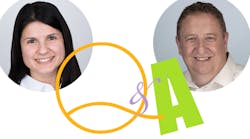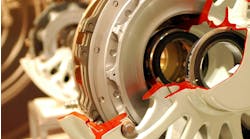Innovations in Hydraulic Seals Driven by Testing and Education Initiatives
Sustainability is playing an important role in product development initiatives for many companies, including Hallite – a developer of seals for hydraulic and pneumatic systems. Although small in size, seals are vital to preventing leaks as well as aiding the efficiency of fluid power components all of which can benefit sustainability efforts.
For Hallite, testing and industry education help drive new product developments, including those which help both the company and its customers meet sustainability goals.
Power & Motion spoke with Andrew Iddeson, Global Technical Director, and Flavia Richards, Global Marketing Director at Hallite about the role sustainability is playing as well as how testing and educational initiatives are aiding with the creation of new hydraulic and pneumatic seals.
*Editor's Note: Questions and responses have been edited for clarity.
Power & Motion (P&M): We know sustainability is a key focus for many companies, including Hallite - what does sustainability mean for Hallite and what are some of the company’s key goals in this area?
Andrew Iddeson (AI): At Hallite we see sustainability in a very broad sense. It means that we're moving to create our products in non-polluting processes, where we can conserve energy and natural resources. But we also need to ensure that we can remain economically sound and safe for our employees, our communities, and our customers.
We have a mission across our business and business activities to foster that culture of sustainability, throughout all our operations. And to encourage positive environmental impacts within our innovation and new product designs, within our process management and operational principles by embedding a roadmap to reduction of our six core ambitions within our environmental positioning. Those ambitions include carbon dioxide (CO2) emissions, energy consumption, reduction in our organic solvents, the waste that we generate, the water that we consume, and of course unsustainable raw materials.
P&M: How is Hallite going about achieving its sustainability goals?
AI: By incorporating these improved sustainability practices into all our processes, we mitigate the potential for any adverse environmental impacts throughout our activities. That obviously helps us achieve our short- and long-term ambitions.
An example might be the selection process that we put to new equipment. When we invest in new molding equipment, for instance, it's driven not only by our operational efficiencies, but also by environmental efficiency. If we can be more environmentally efficient, some of that equipment can reduce our energy demands.
P&M: What, if any, impacts will Hallite’s sustainability initiatives have on its products, both legacy and new products?
AI: [For] new products, Hallite has now adopted the lifecycle assessment framework. This is a method for assessing the environmental impact of a product throughout its entire lifecycle. This method allows us to quantify and continuously improve the products, new and legacy, in terms of their environmental impact. That could be simple things [such as] the choice of materials we use, selecting materials that are renewable or recycled. But it also goes further into looking at the efficiency of the energy and the water that we consume, as well as our waste management.
And then going into the product design, we look at the longevity of the product [and] reducing waste of the product at the end of life. It's sealing effectiveness; we're talking seals so if we can reduce oil losses and emissions in application, and then even further into the reduction of the energy consumed within the fluid power system, all these elements result in continuously improved efficiency and performance of both the new and existing products.
One of those examples may be the effectiveness of seals in a fluid power system where they rely on the interaction of the dynamic surfaces and therefore the drag that is produced in application is from the frictional forces. Well, that drag in the system demands energy. And so higher drag means [more] energy required to drive that fluid power component such as a hydraulic cylinder. If we can reduce the friction, it directly impacts the energy consumed in service.
READ MORE: Managing Friction to Optimize Hydraulic Cylinder Performance
P&M: How can seals potentially aid with sustainability efforts customers may have?
AI: Going back to the lifecycle assessment, it recognizes that although we have a responsibility to drive efficiencies within our manufacturing, and the aspects under which we have control, the environmental impact of the product in use is equally or possibly even more relevant. We work with our customers to understand their needs during the use of the seal. [This includes] the end-of-life phase – the product disposal – and taking any steps that we can to minimize the impact after it's left our facility, throughout its entire life.
P&M: Are there new products the company is developing specifically to aid with sustainability efforts of customers, the industry and/or its own objectives? If so, can you provide some examples and how they will help to meet sustainability goals?
AI: The validation of the performance of some of our new products that are coming [out] will be seen at the International Fluid Power Exposition (IFPE). They demonstrate that point – that endurance, leakage, and friction performance results which help the customer in contributing to reduced drag in the hydraulic system just by us being able to manage friction around the seal. But then going into that improvement in durability, for instance the functional sealing effect by extending the cycles ensures a longer life in the product. And of course, that contributes to reducing waste.
But more critically, the improved seal function. Boundary layer lubrication is a critical part of a seal function in hydraulics, but it can often be perceived as leakage. And leakage has an environmental impact. So through our endurance and leakage tests we can show that significantly reducing leakage rates when compared to industry acceptance levels can have a positive impact.
Visit our IFPE channel to learn more about the show and technologies on display from Hallite and others in the fluid power and motion control industries.
P&M: Since we’re on the topic of new products, what are some of the key areas in which Hallite is focusing its efforts in the area of innovation?
AI: New product development is a big part of where we are today. And in order to bring those products [to market], testing has always been a fundamental part of our history. We work within our own laboratory and test house in the UK, [as well as] in partnership with the Milwaukee School of Engineering (MSOE).
READ MORE: Seal Supplier Partners with MSOE for New Test Method
Testing has been one of those pillars and foundation elements for Hallite capabilities, and a constant driver for our growth. Almost all of our legacy and current products are developed and launched from our own testing programs. We had a recent expansion of our test facility in the UK, and we're now equipped with a wide range of material and product characterization tools that has enabled us to drive research in sustainable solutions [and] in typically challenging materials like polyurethane.
And the work that we're doing with Milwaukee School of Engineering has always been focused on pushing the boundaries of testing, driving excellence in validation and performance of products. That's still really a big part of our focus and recent investment in novel rigs, which have allowed us to understand lip seal temperature or ingression of dirt past wipers are some of those examples.
P&M: What are key features customers are looking for which are driving Hallite’s new product innovations?
Flavia Richards (FR): Going back to the Hallite brand, one of the key values and differentiators for it is delivering meaningful innovation. And what we mean by that is our new product development and introductions which are a result of that [meaningful innovation] are very much designed and developed in partnership with our customers and in response to very tangible needs of the industry.
Every customer challenge is different, and we recognize that, but we also ensure that our technical experts work closely with our customers to deliver a solution that works to not only help resolve, but in some cases outperform on their challenges. That's very important for us.
P&M: What would you consider Hallite’s most innovative product introduction to date, and how does it benefit the industry?
FR: Hallite…[has] been around for over 100 years now. And partnership has always been at the heart of our company throughout, giving our customers complete confidence in the performance of the hydraulic cylinders. That's what we strive to do, and provide seals, wipers and bearings of proven quality.
We strive to offer our customers the best of both worlds, where they have a local team that they get to know and they can trust, [and] also they have the support of technical, capable experts within our global network.
Throughout our history, we've introduced many product innovations, and most of these products are still recognized solutions today. The Hythane materials and the introduction of the T605 U-cup seal are good examples of these. Introduced in the 1980s, they still represent the backbone of the Hallite brand. Another example that I could bring up is our first entry into mining leg cylinders [developed] in partnership with leading OEMs, which provided innovation opportunities in new seal styles, such as the T730 that we will present at IFPE as one of our portfolio products.
In the 1990s, we also introduced the Umbrella Wiper Technology. This was another example of a new product where customers operating equipment in particularly harsh environments – whether it was long wall mining, agricultural, forestry or aggregates – could benefit from the contamination protection that this technology provides.
At IFPE this year we will be representing these, as well as introducing new products and innovations, which again are designed around our customers’ needs. And we're excited and look forward to talking about these solutions [with the industry].
P&M: We know industry education is important, especially today with current workforce challenges. How is Hallite going about educating the industry about sealing technology and how it can benefit hydraulics systems?
FR: Education is another hot topic in our industry at the moment, and we recognize that amongst our competitors as well. But thought leadership in education has always been very high on the agenda of our team because education is another key area of focus within Hallite when it comes to innovation.
Our customers have recognized us as the specialist in hydraulic cylinder seals and therefore our aim is to share this expertise with the younger generation now of fluid power engineers, as well as our partners in our industry. We believe that this is pivotal to encouraging and driving innovation.
It is for this reason that we've developed two training modules Fluid Power 101 and Fluid Power 201, and we aim to open these platforms to a broader audience through a webinar-based education plan that we have started over the last 2 years and we are further expanding. We also plan to go further by establishing new relationships with local education institutions around the world to really support the education of young engineers in the industry of fluid power.
P&M: Speaking of bringing younger generations into the industry, which is something fluid power especially struggles with, is there anything in particular Hallite is doing to attract the younger generation, or that the industry could be doing?
FR: I certainly wouldn't like to comment on behalf of the industry, but there's certainly things that we are doing as a company to ensure that we're sharing the expertise and the work that we're doing with the Milwaukee School of Engineering is really a testament to that. Our relationship with MSOE is important because we work with young engineers, get them excited when we use the phrase ‘What if we could do this?’ The students are engaged in projects from ‘let's build it and make the best type of [product]’ to ‘let's create something new, let's raise the benchmark.’
We certainly feel that we're helping educate our next generation of fluid power engineers by working with educational institutions across the world. We're also creating opportunities for both organizations, developing joint marketing activities that work to continue in building interest and momentum for our organizations and we certainly will look to continue doing that and developing it further.
P&M: Earlier in our discussion we were talking about testing. Can you go further into the role testing has played in Hallite’s product development efforts and what role it might continue to play in the future?
AI: Testing is key to everything that we do, and particularly a high level of interest from my point of view, but we pride ourselves on the fact that we've been able to do this throughout the history of our company. And we mentioned it earlier about supporting all of our products, the legacy and new, with test data.
We've always had that testing capability. Being able to do that testing provides the test data which then underpins the benefits of the products that we're promoting. Testing has been key to the whole product development process. Data gives the customers the confidence that they know they are making the right choice. And it supports the promise that we make to them.
It allows us to better understand the impact of seal function and quickly benchmark any improvements and understand where the benefits are to our customers. Instead of walking in and just [saying] ‘We think it should be better’ we can present that test data that really turns that theory into a compelling design improvement.
We can benchmark against other seal designs in a portfolio and other materials. And we get great guidance around how products can compare. That gives us great information, understanding the strengths and weaknesses in products and gives us the ability to provide the best seal package based on solid test data.
And what's more, now that we're in partnership with MSOE, it's independent. That testing is performed by an unbiased, educational institution and Flavia mentioned earlier about broadening our reach to educational institutions – this gives further confidence to our customers that we can provide a product that is validated correctly and can stand behind the data that we deliver.
P&M: How does the company continue to improve upon or re-evaluate its testing needs and capabilities?
AI: Innovation, by some level of definition, is always moving on and innovation in our products and processes, we've spoken about it previously, will always put demands on our testing. And going back to one of the other points, partnership, it supports that market understanding. Partnership with our customers, with MSOE, or we contribute on industry bodies such as the National Fluid Power Association (NFPA) and ISO (International Standards Organization) committees; that gives us awareness of the trends and the demands in the fluid power industry. And that drives us to re-evaluate our testing where necessary and ensure that both the testing [and] the products remain valid and valuable to our customers.
P&M: On the subject of industry partnerships, are there specific types of testing the industry is looking for or specific information it is looking to gain?
AI: A lot of the testing that we're engaged in is, as I said, through partnership and we're listening to what the customers need. And clearly we are in a need to be more sustainable. We talked about it earlier, trying to bring all of that information together to prove the sustainability points to give the proof of [seal] function. Certainly, there are trends around the industry [and] we listen to those trends and we react accordingly.


